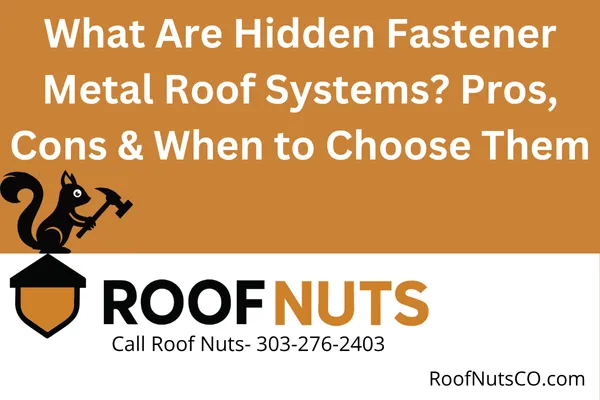
What Are Hidden Fastener Metal Roof Systems? Pros, Cons & When to Choose Them
Hidden Fastener Metal Roofing: What It Is & When to Use It
If you're considering a metal roof for your home or commercial property in Colorado or Georgia, hidden fastener systems (also called concealed fastener systems) are one of the cleanest and most popular choices. But what makes them different—and are they the best option for your climate, home design, or budget?
Here’s what you need to know.
What Is a Hidden Fastener Metal Roofing System?
Hidden fastener systems use metal panels that snap or lock together, concealing the fasteners beneath the surface. Unlike exposed fastener systems (like corrugated or R-panel roofs), there are no visible screws penetrating the face of the panels.
They’re most commonly found in:
Standing seam metal roofs
Snap-lock systems
Mechanically seamed panels
Key Benefits of Hidden Fastener Metal Roofs
1. Cleaner Look
No screws or washers are visible from the surface, giving your roof a sleek, modern look. Ideal for custom homes or high-end commercial buildings.
2. Lower Long-Term Maintenance
No exposed screws means fewer potential leak points. This makes them less vulnerable to weather-driven wear or screw back-out over time.
3. Improved Water Shedding
Panels interlock in a way that directs water efficiently off the roof—especially important for heavy snow and rain events in Colorado’s mountain regions or Georgia's stormy seasons.
4. Better Expansion/Contraction Control
Concealed clips allow panels to float slightly. That’s key in states like Colorado and Georgia where daily temperature swings are large.
Potential Drawbacks
1. Higher Installation Cost
These systems require more labor and precision to install. Mechanically seamed systems often need specialized equipment.
2. Slower Installation Time
Expect longer project timelines due to more detailed panel alignment and seaming.
3. Not Ideal for Very Low-Slope Roofs (Unless Specified)
Some hidden fastener systems are not watertight unless fully seamed or designed for low-slope roofs. Always check compatibility with your roof pitch.
Ideal Use Cases for Hidden Fastener Systems
Residential homes with high-end finishes
Commercial buildings where appearance matters
Cabins or mountain homes in Colorado needing robust snow performance
Coastal or humid areas in Georgia where leak prevention is critical
Properties with solar panel systems—these roofs accommodate mounting without penetrating the surface
FAQ
What is the difference between hidden and exposed fastener metal roofs?
Exposed fastener roofs show screws on the surface and are quicker and cheaper to install. Hidden fastener roofs hide all attachments, creating a more watertight and cleaner finish.
Is a hidden fastener roof worth the extra cost?
If you value long-term durability, aesthetics, and low maintenance, yes—especially in areas with extreme weather or when curb appeal matters.
Can hidden fastener metal roofs be used on low-slope roofs?
Only certain systems, such as mechanically seamed standing seam panels, are approved for low slopes. Snap-lock versions typically require steeper slopes.
Get Help Choosing the Right Metal Roof
At Roof Nuts CO and Roof Nuts GA, we specialize in installing high-performance hidden fastener metal roofing across Colorado and Georgia.
Our local crews understand the snow loads in Fort Collins and the humidity in Savannah. We’ll help you choose the right system for your climate, budget, and building design.
Call us today:
Colorado: 303-276-2403
Georgia: 404-476-6851
Or request a free consultation at:
https://RoofNutsCO.com
https://RoofNutsGA.com
